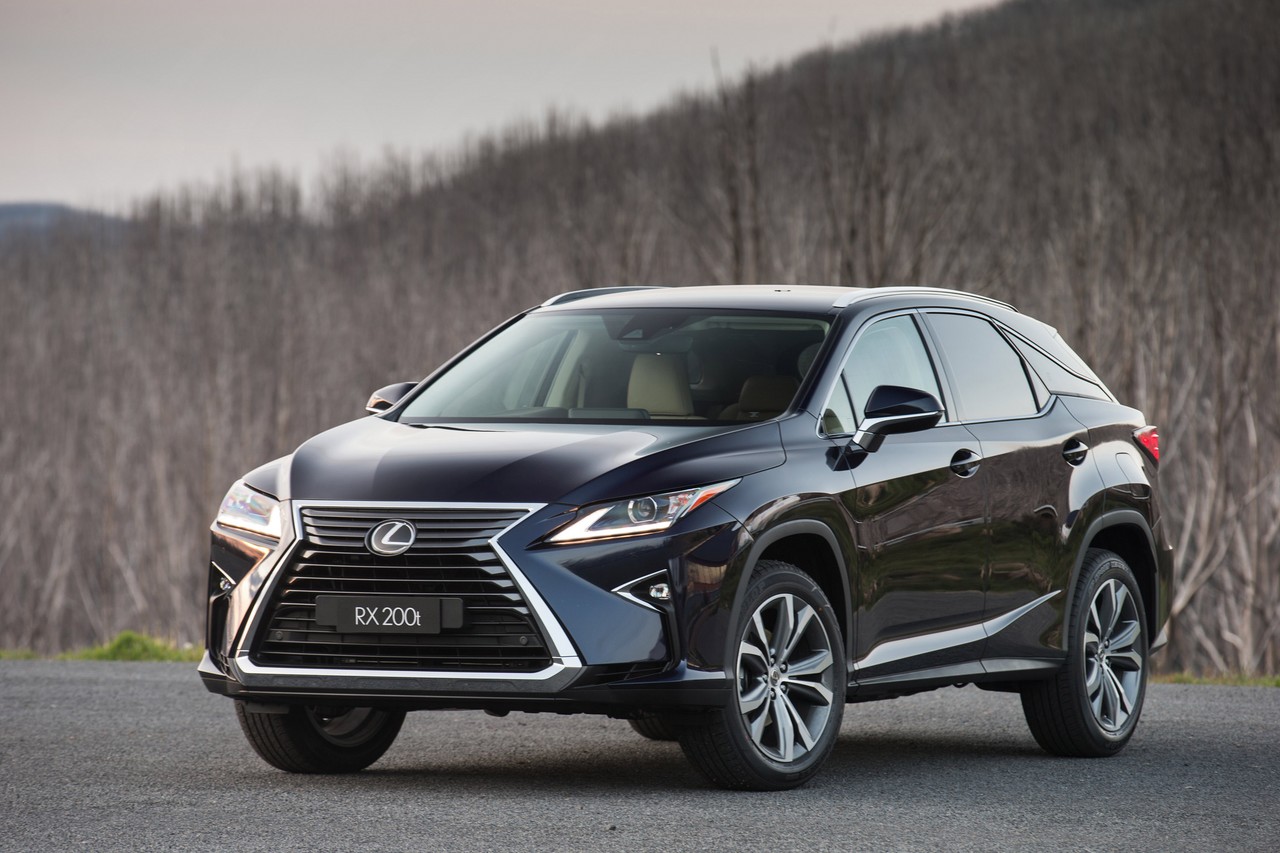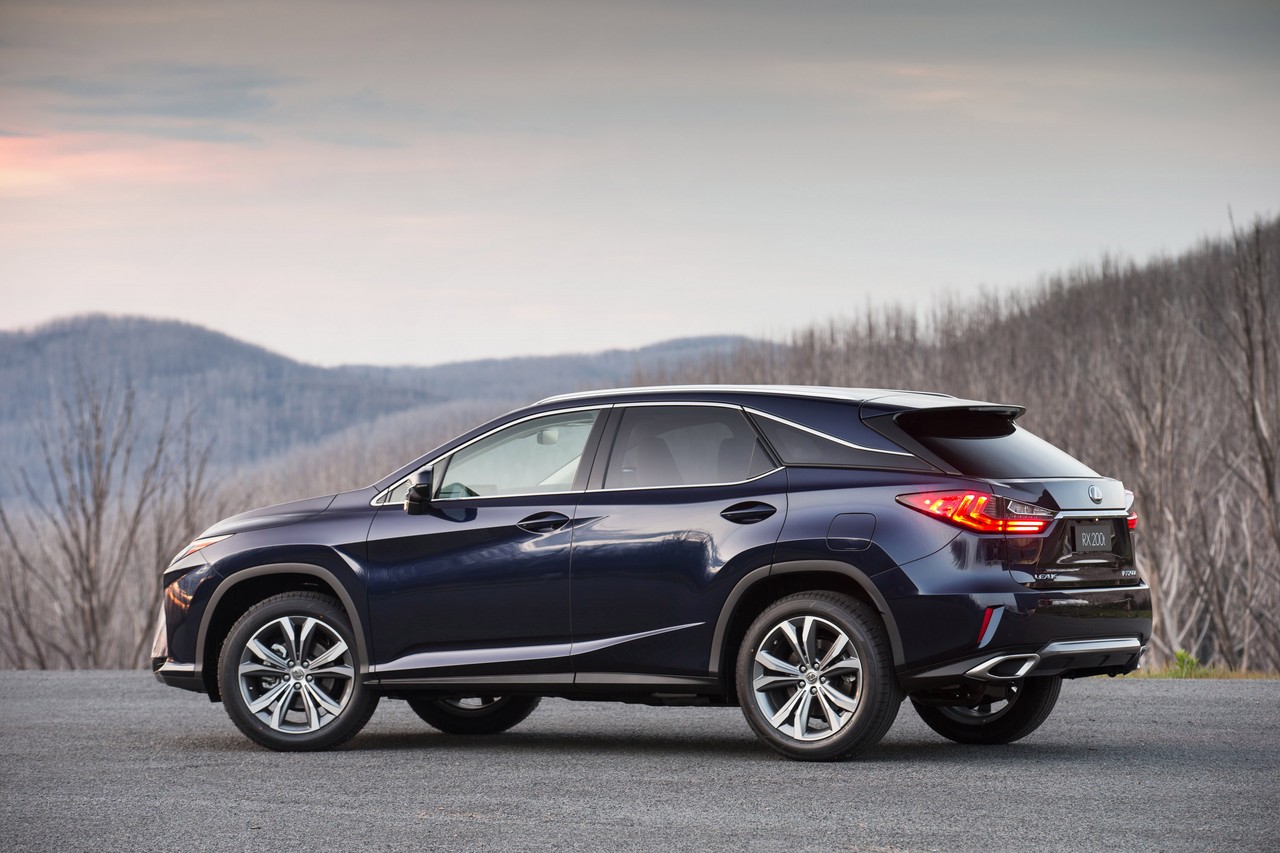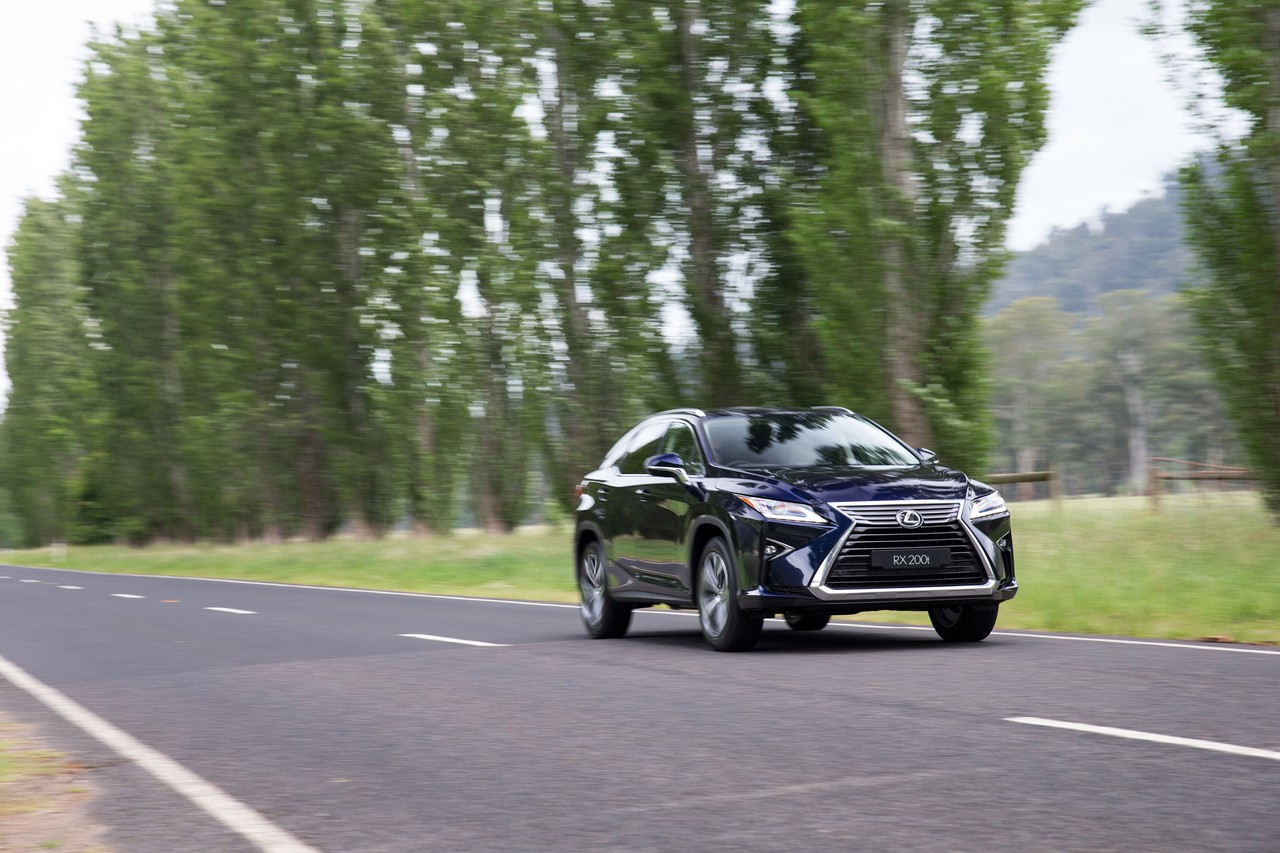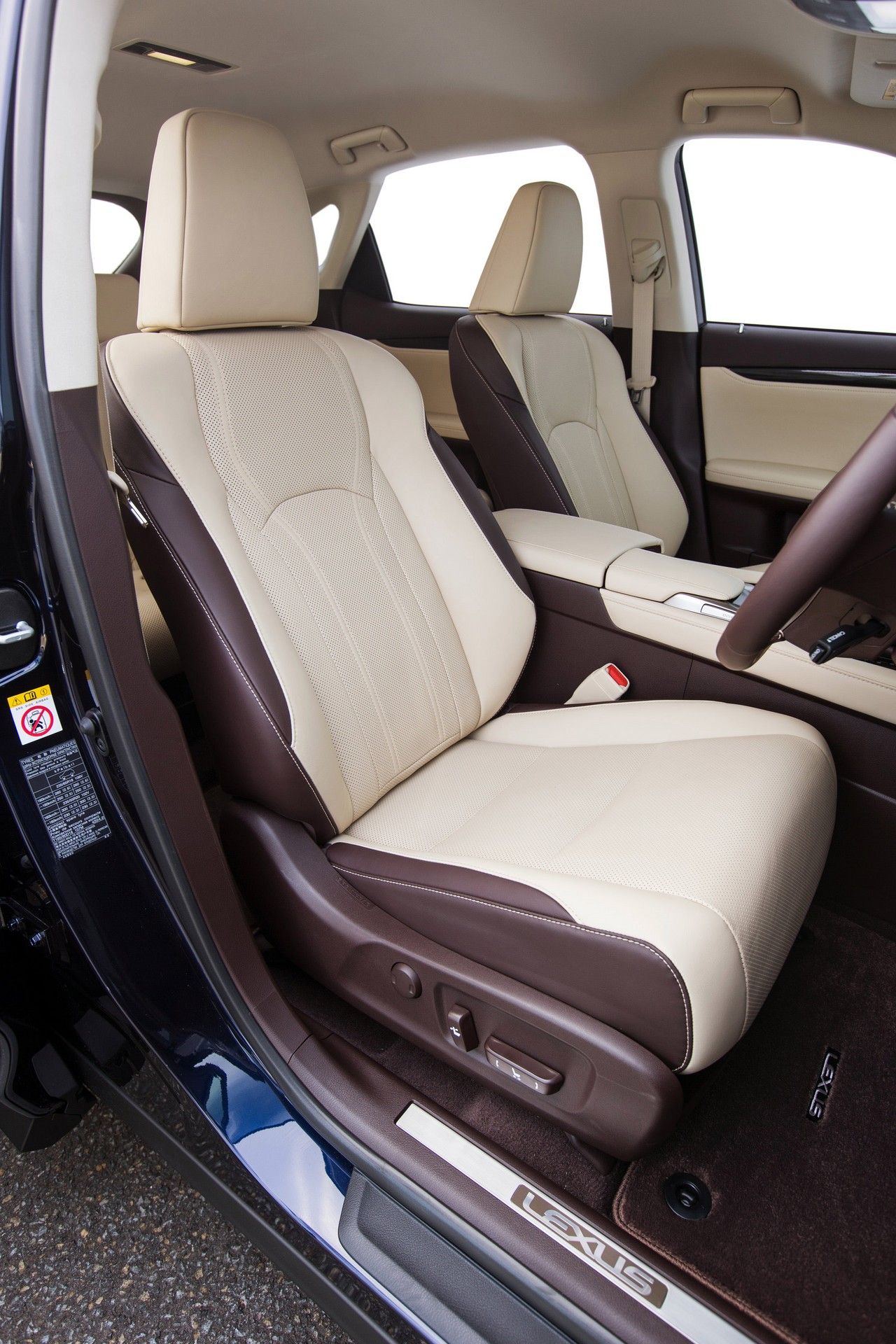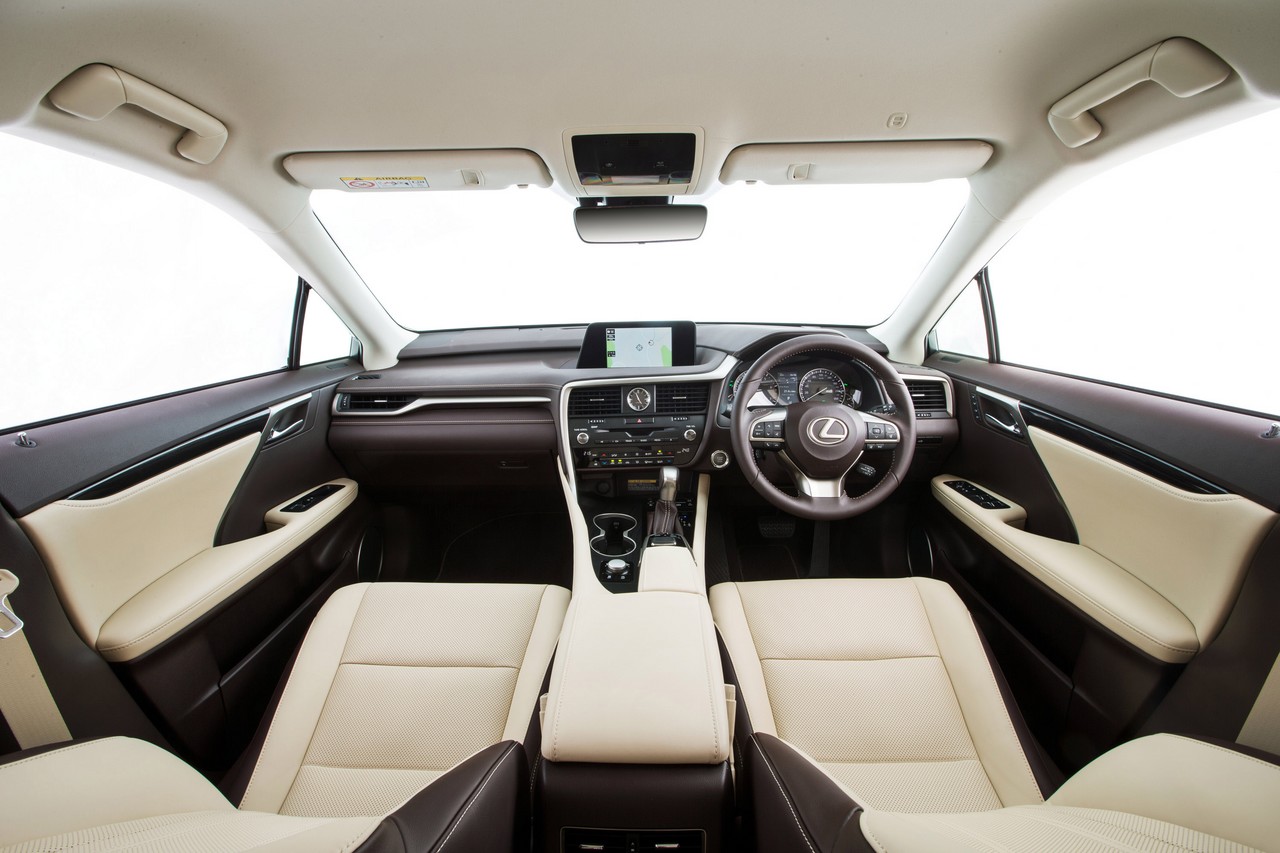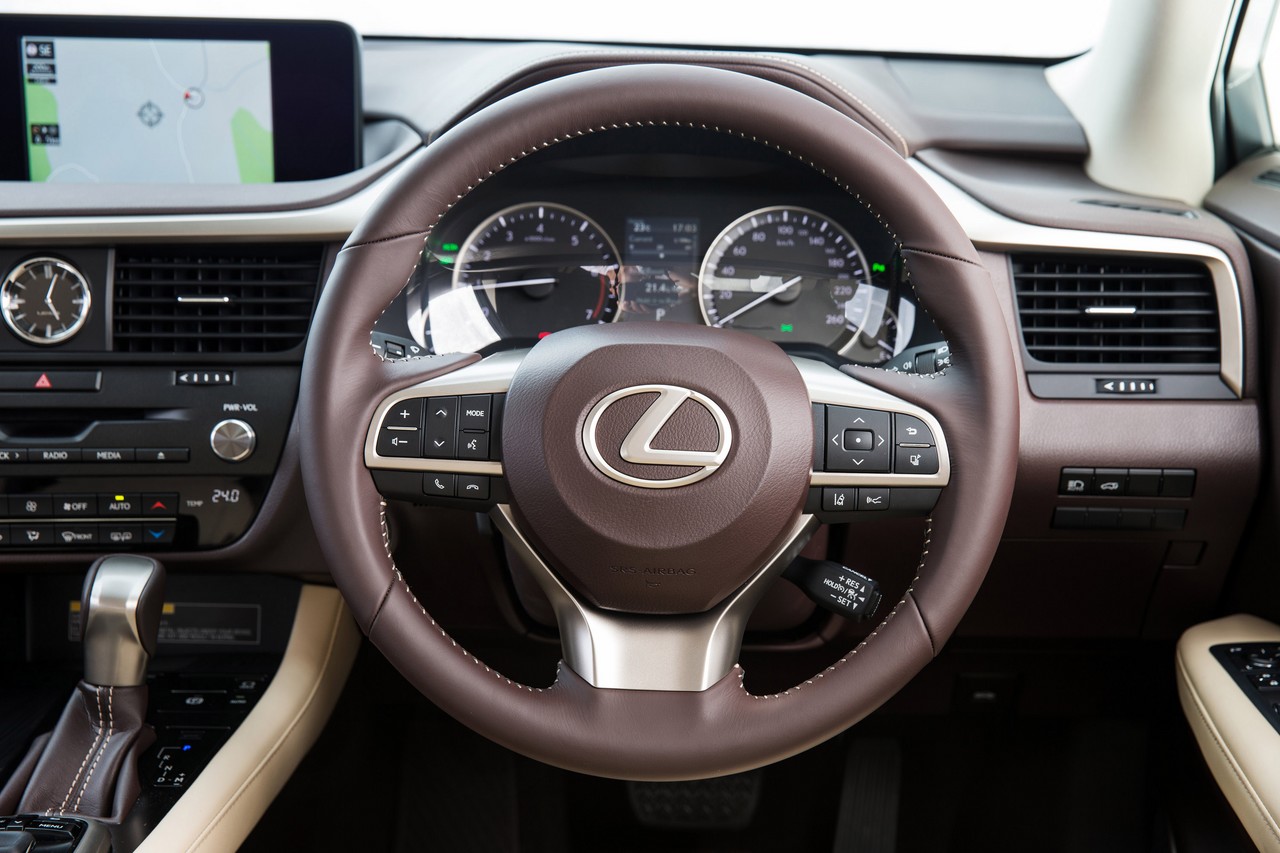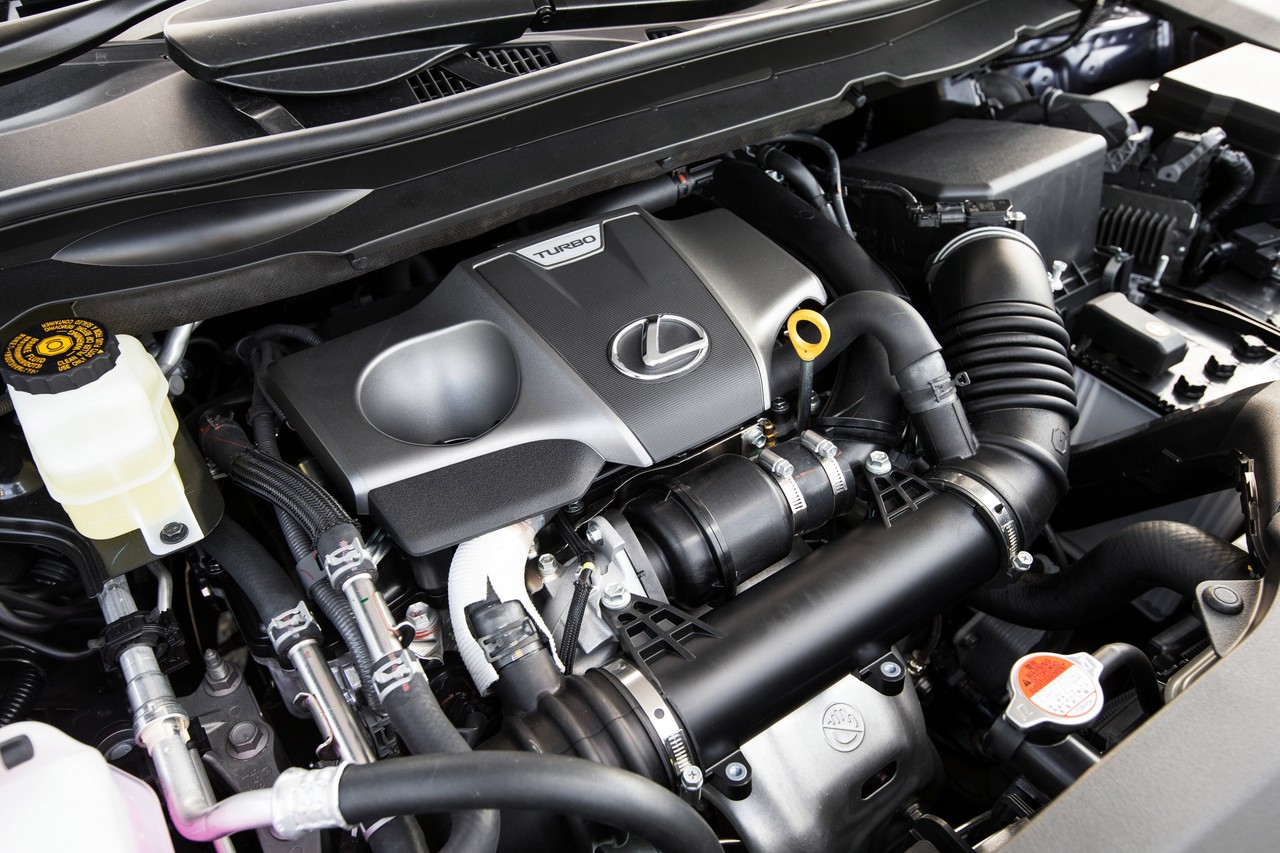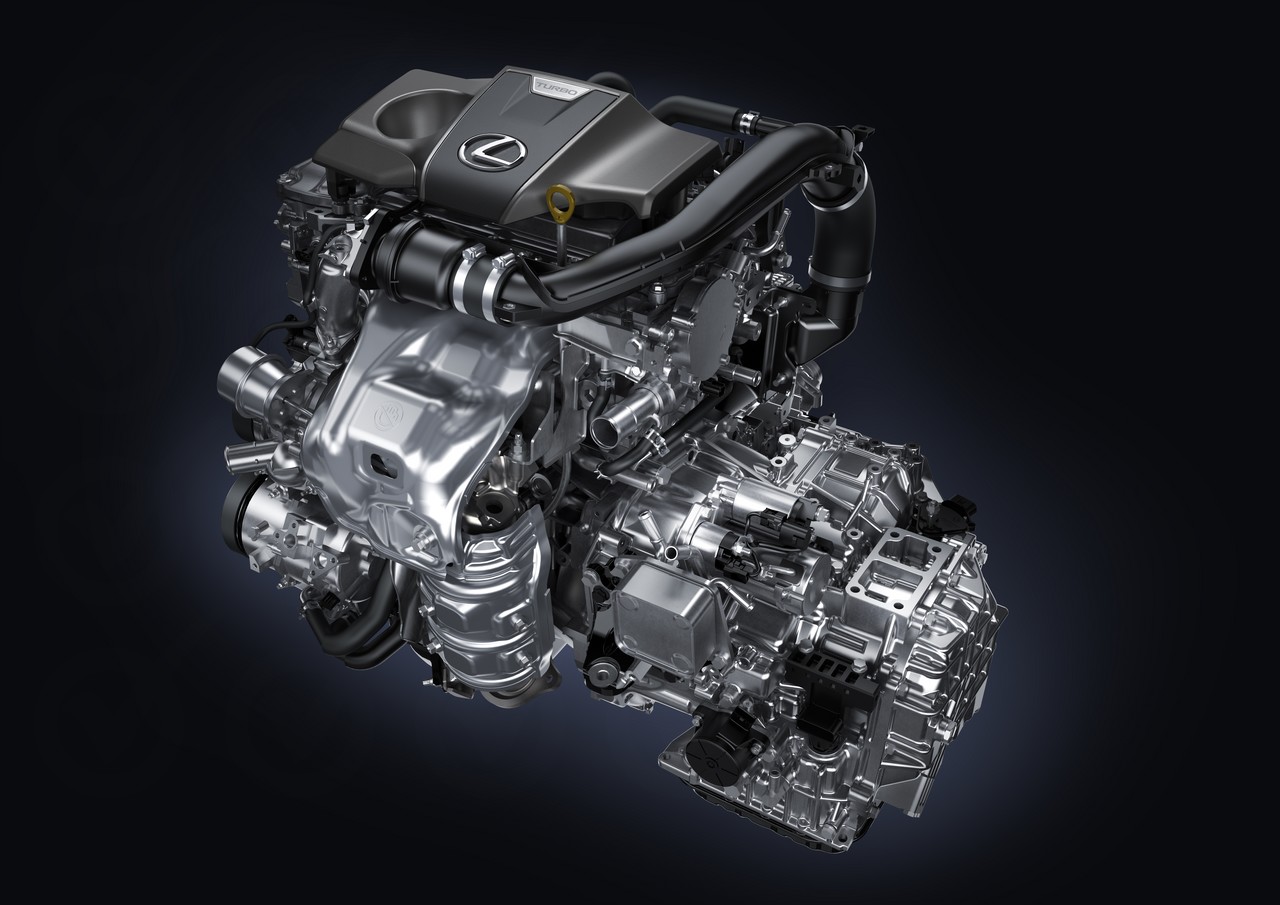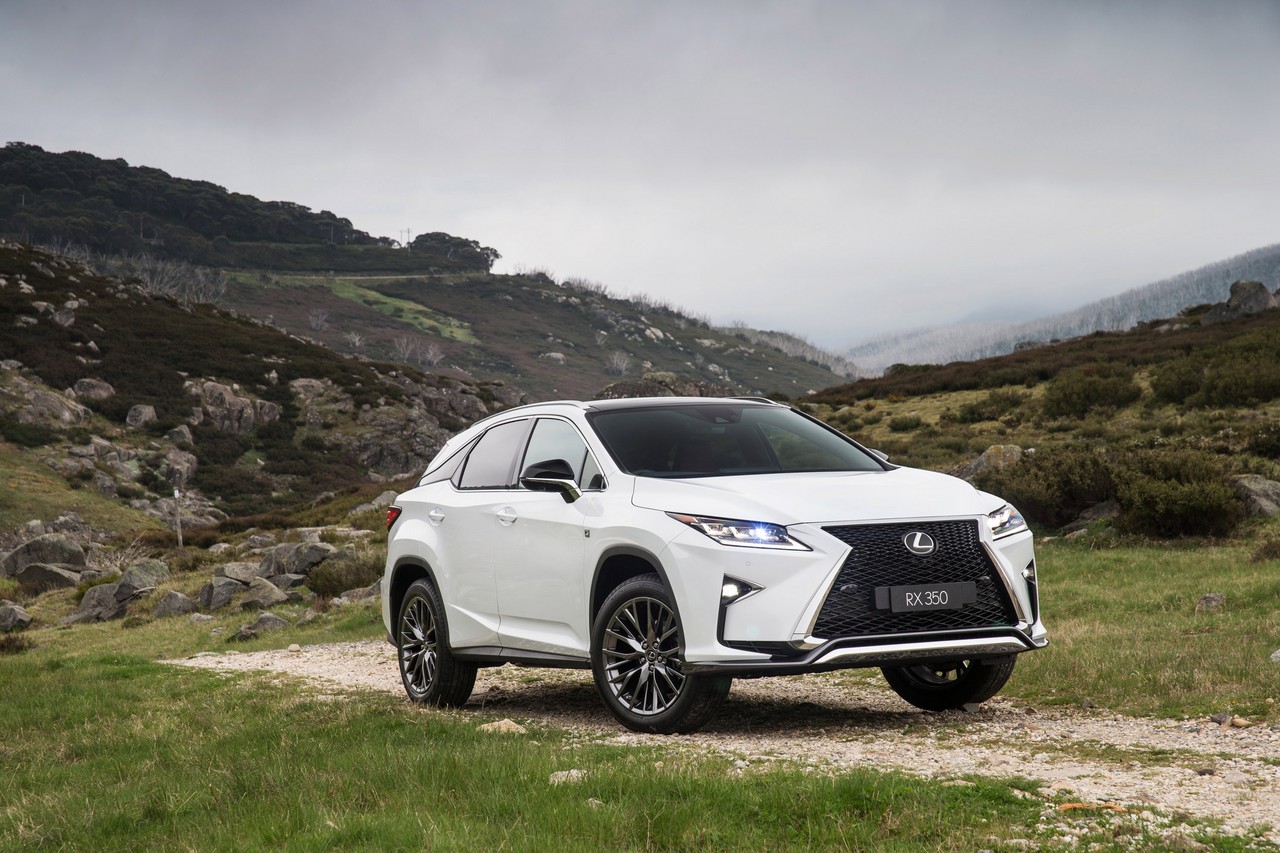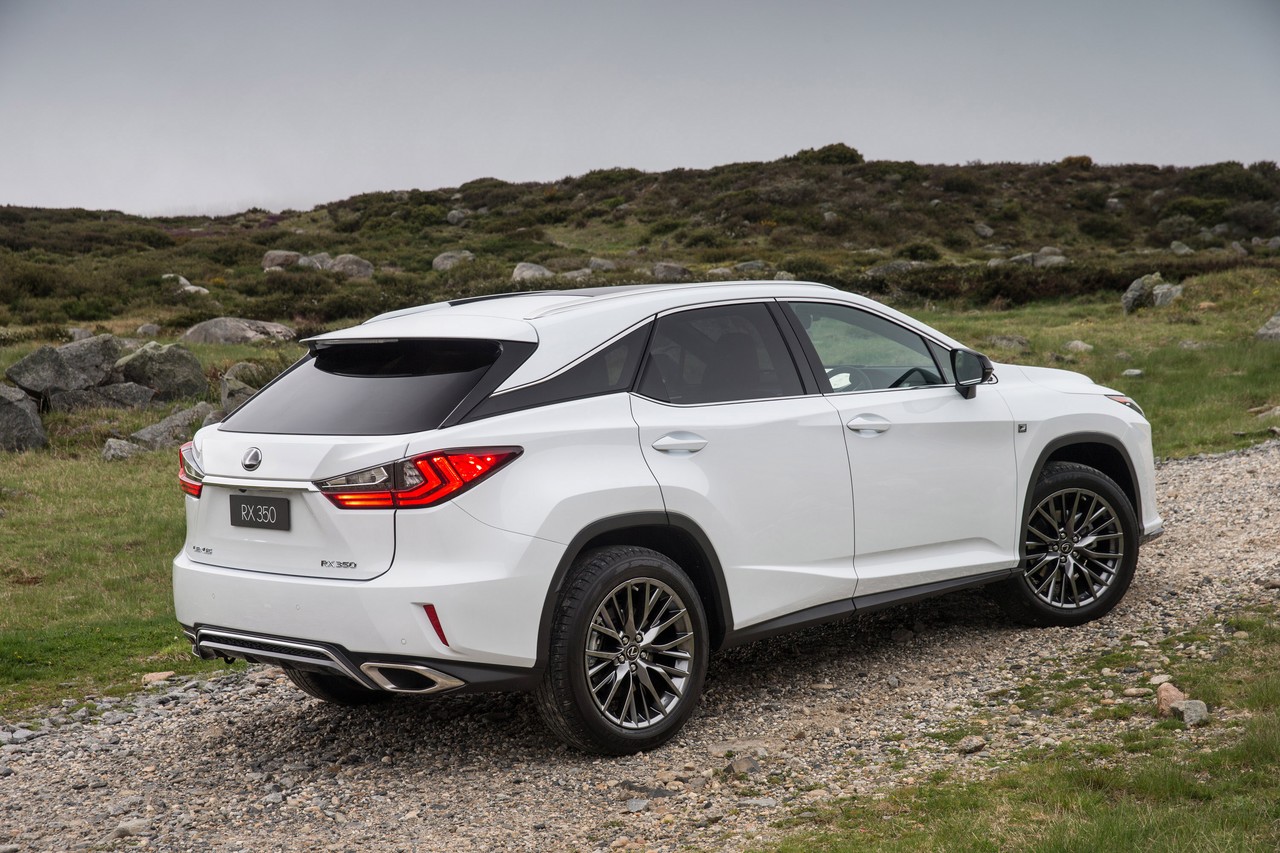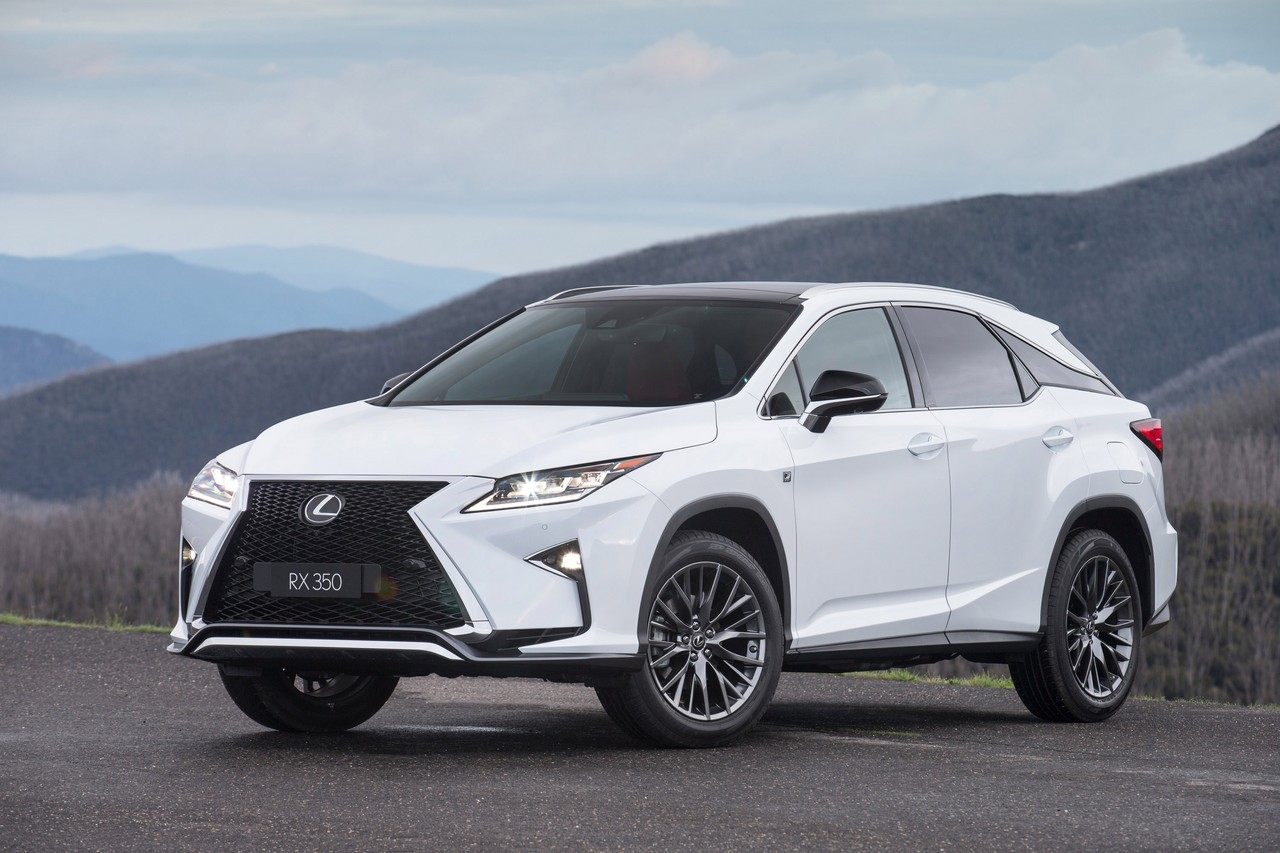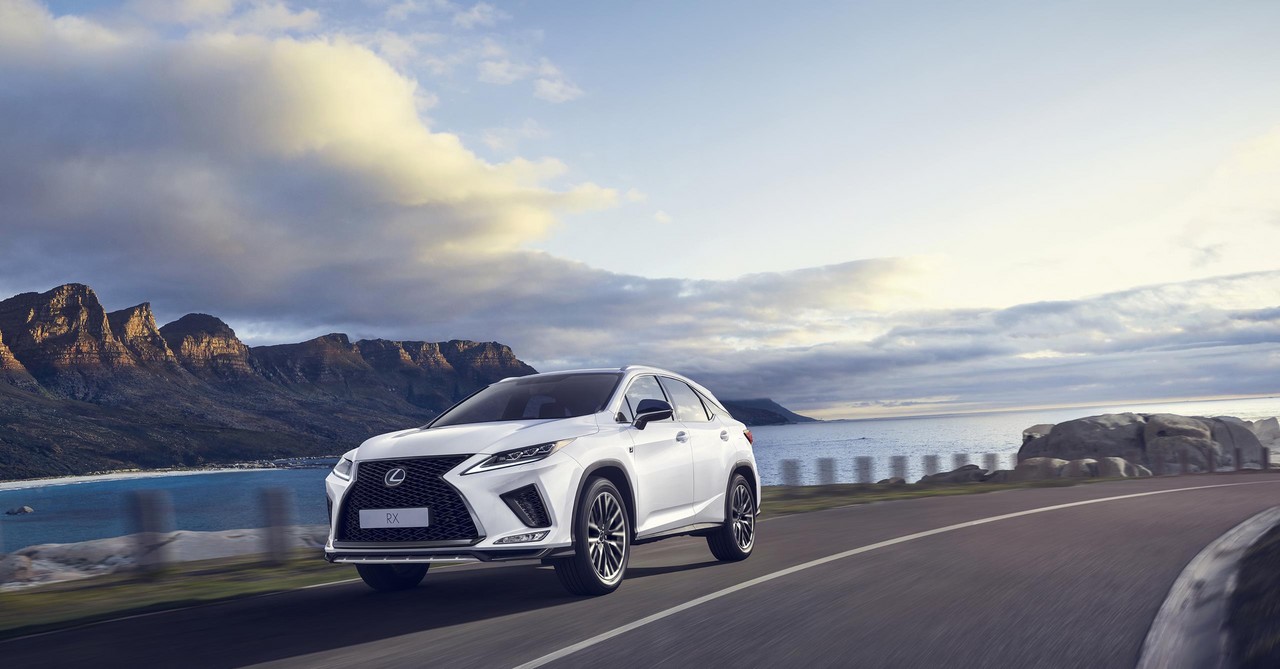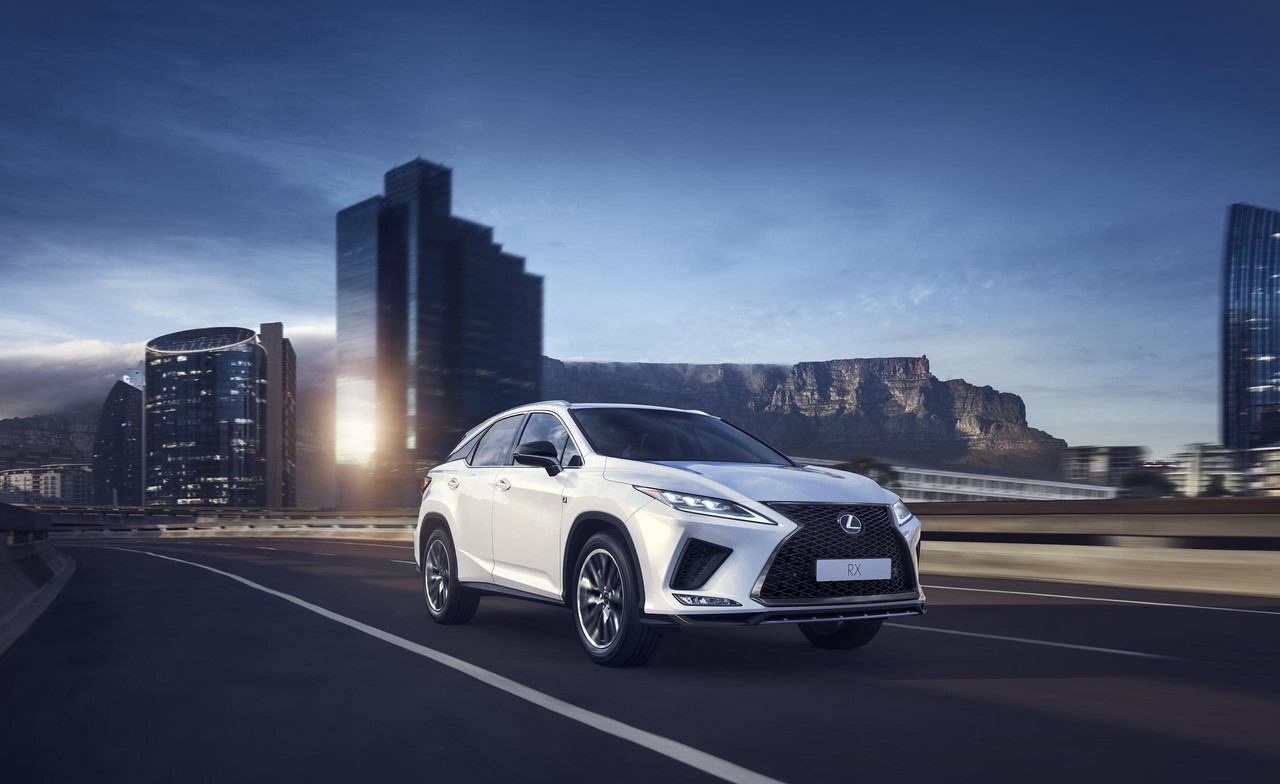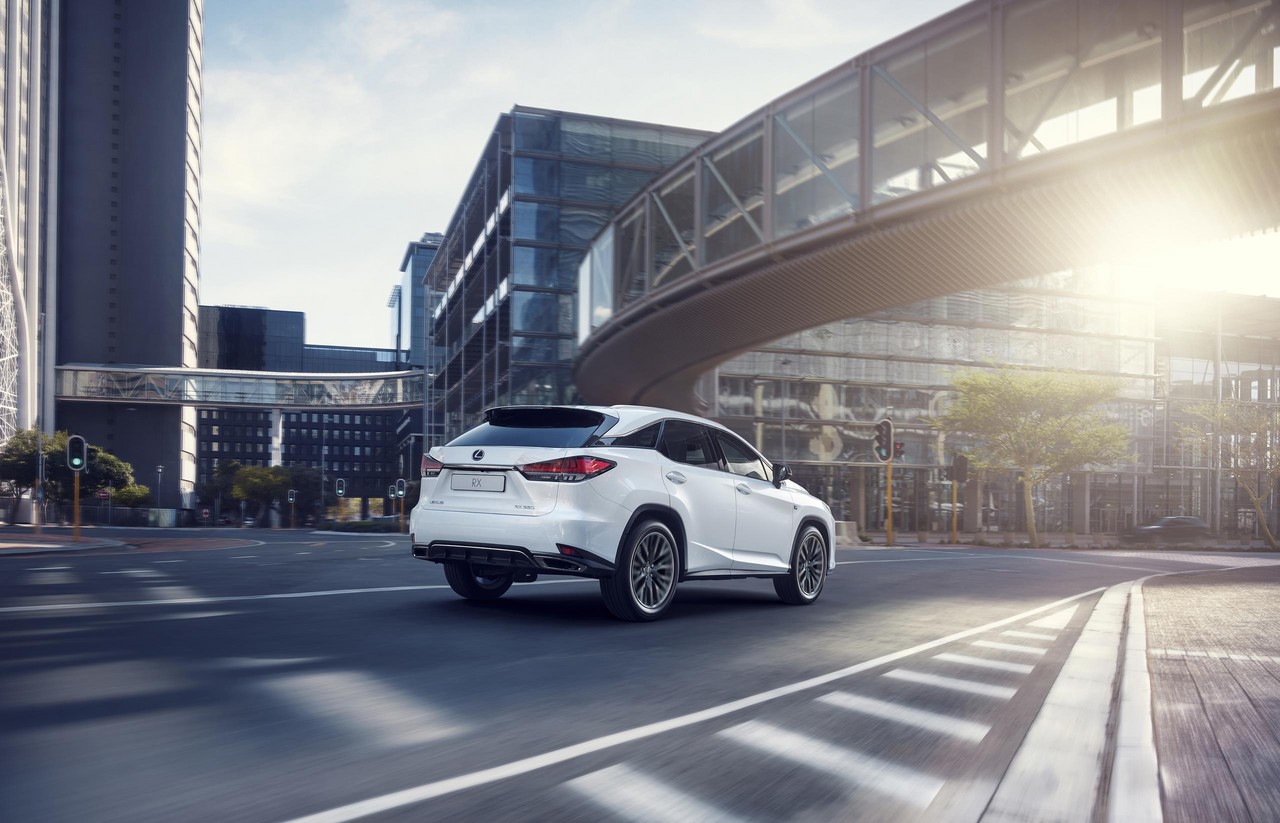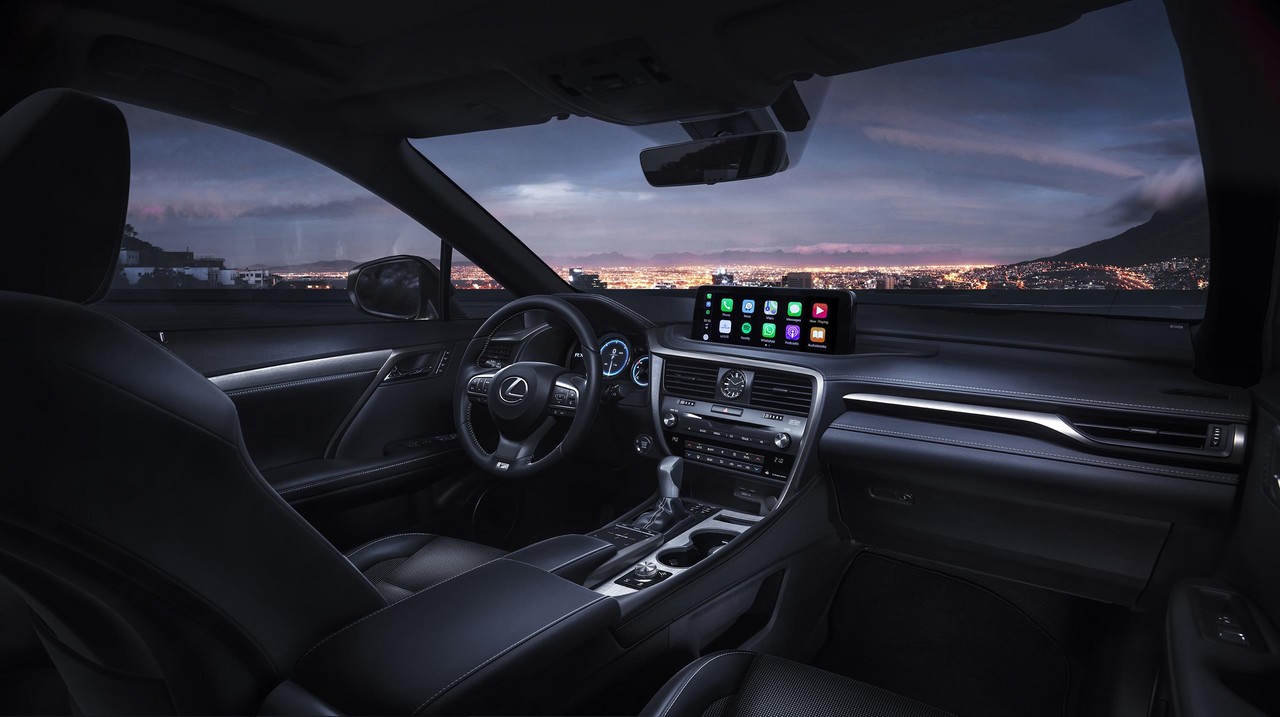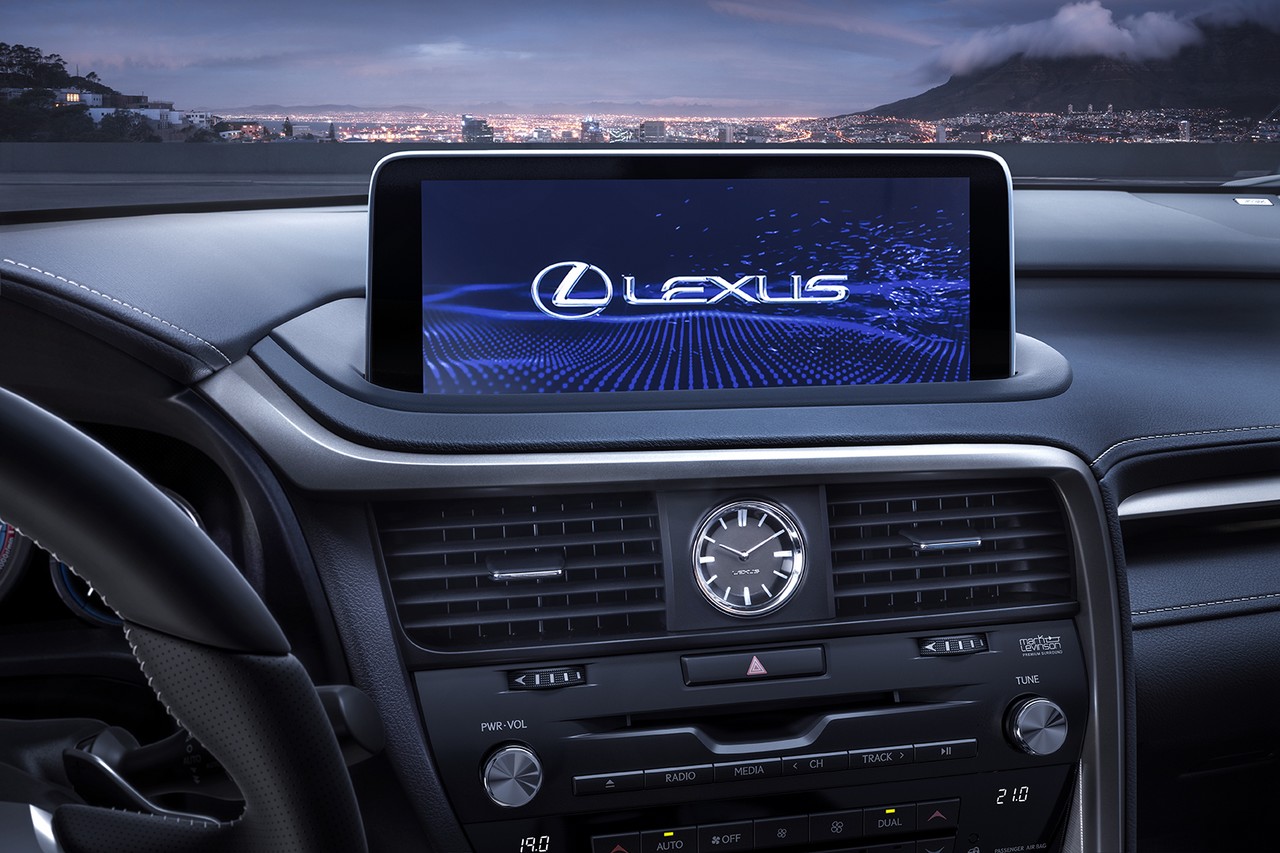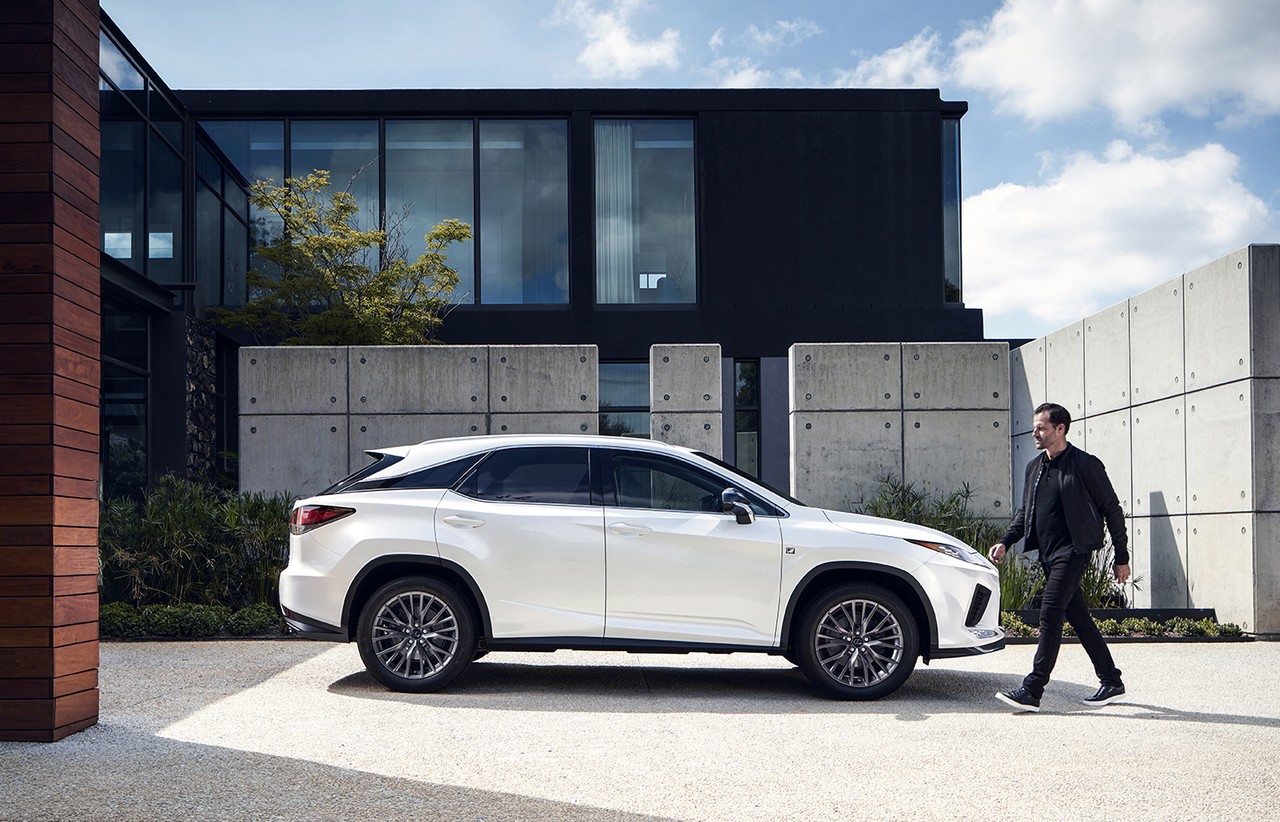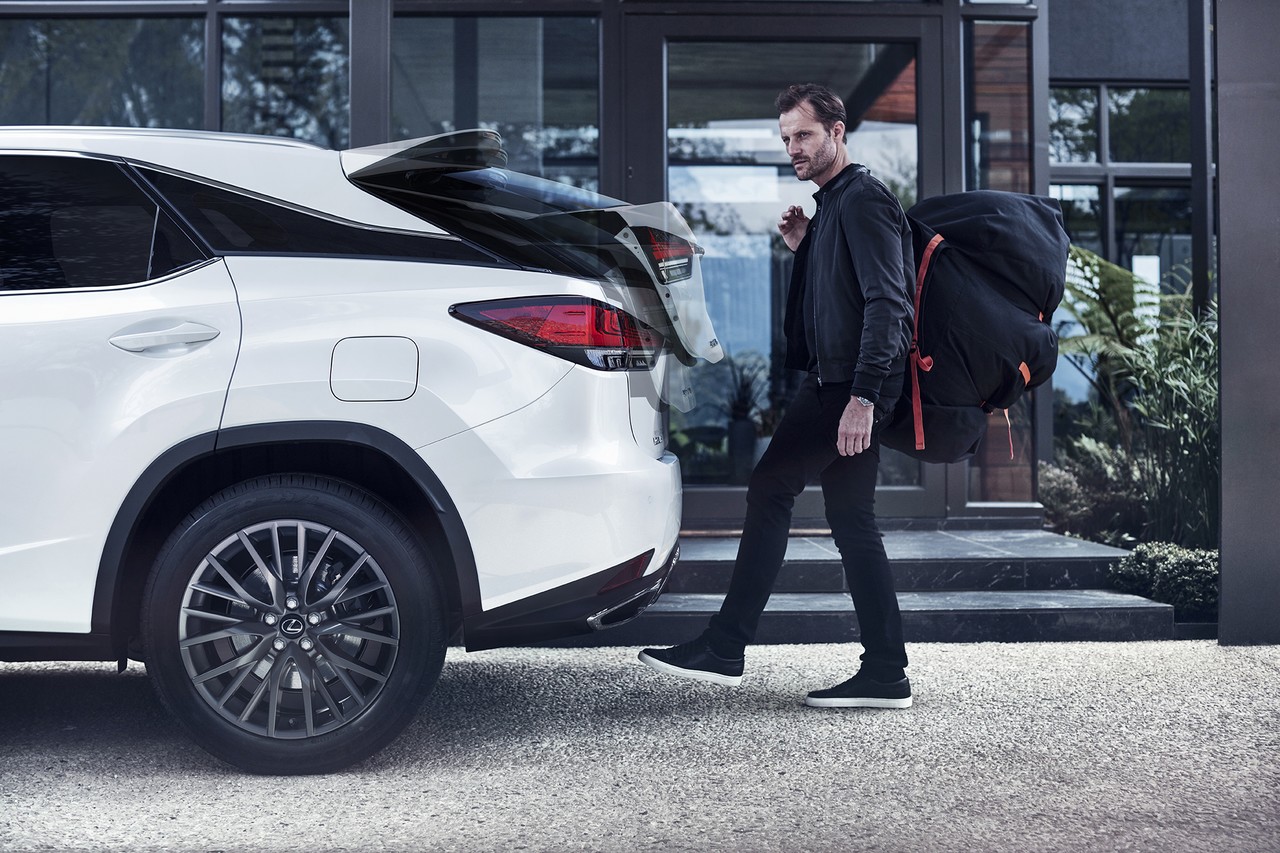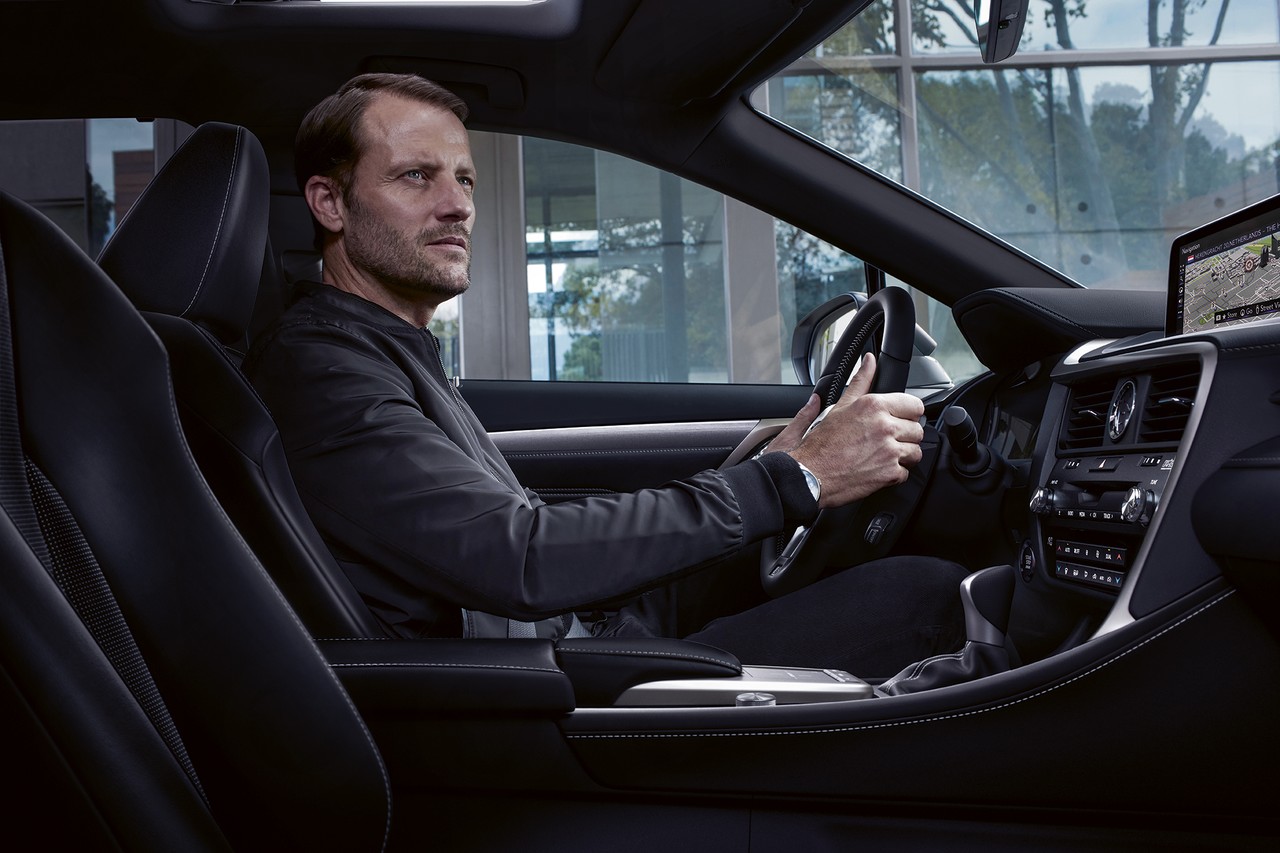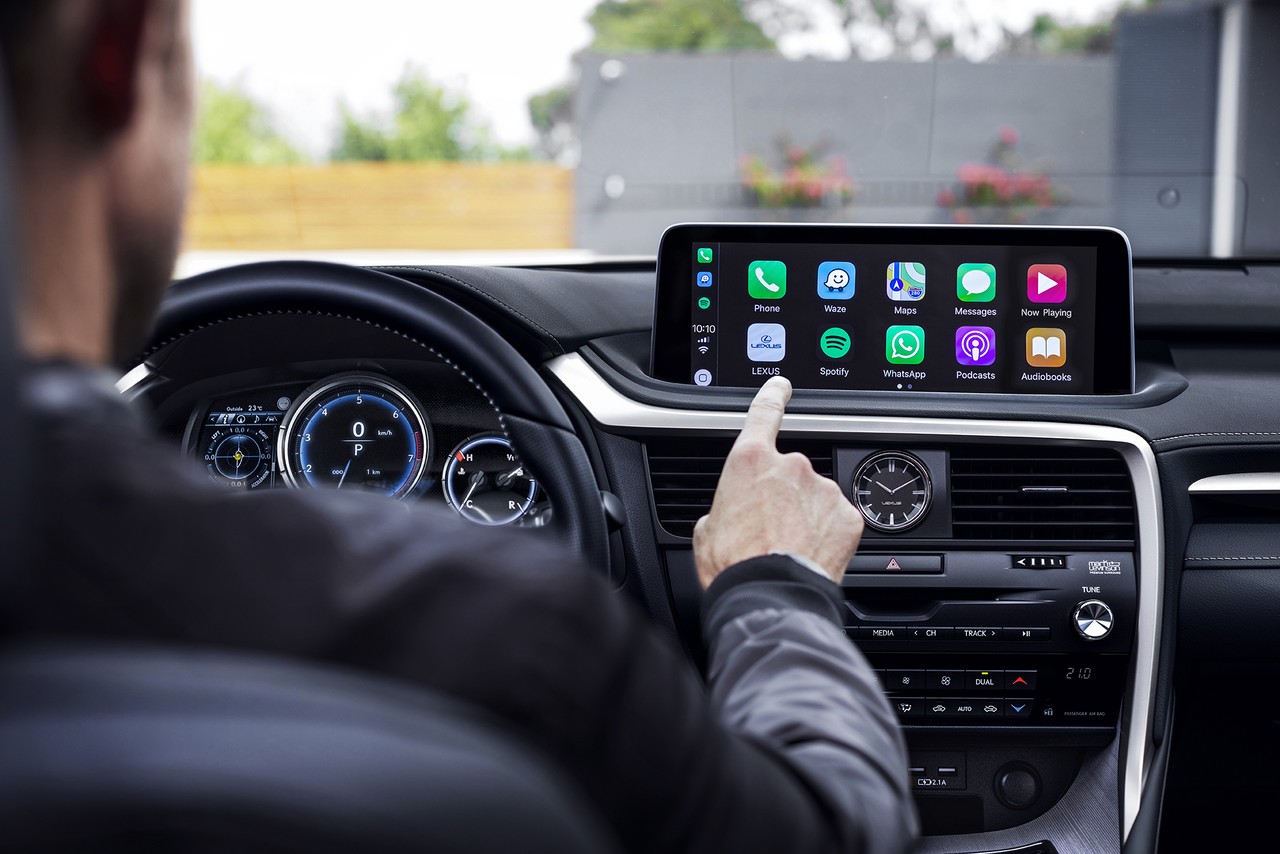
- For RX 200t/RX 300, willing 2.0-litre 8AR-FTS turbo engine
- For RX 350, free-revving 2GR-FKS V6 engine
- For RX 350 and RX 450h F Sport and Sports Luxury, Adaptive Variable Suspension provides decent ride quality
- High standard of interior fit and finish
- Quiet, well-insulated cabin
- Availability of seven-seat version (for third-row occupants up to 160 cm)
- Slow turn-in response and numb steering
- Ride quality hurt by 20-inch wheels and low-profile tyres (other markets get 18-inch wheels)
- Cargo floor is high and shallow
- Infotainment system can be difficult to use
Review: Lexus AL20 RX 200t, RX 350 and RX 450h (2015-19)
Overview
Released in Australia in November 2015, the Lexus AL20 RX was a large SUV with five seats. Manufactured in Miyawaka, Japan, the Lexus RX range initially consisted of RX 350 and RX 450h models, with the RX 200t following in October 2016. While the front-wheel drive RX 200t was solely available as a Luxury variant, the all-wheel drive RX 350 and part-time four-wheel drive RX 450h were available in Luxury, F Sport and Sports Luxury variants (see table below).
In February 2018, the Lexus AL20 RX range was expanded with seven-seat RX 350L and RX 450hL variants which had an additional two-seat third row. According to Lexus, the third row seats were suitable for people up to 160 cm tall. The RX 350L and RX 450hL were available in Luxury and Sports Luxury variants. Furthermore, the RX 200t was renamed the RX 300.
RRX 200t and RX 300: 8AR-FTS engine
The Lexus RX 200t and RX 300 were powered by Toyota’s 2.0-litre 8AR-FTS turbocharged petrol engine which had an aluminium block and aluminium cylinder head, direct and port injection (Toyota’s ‘D-4S’), a twin-scroll turbocharger (which provided maximum boost pressure of 17 psi or 1.17 bar), an air-to-liquid intercooler, integrated exhaust manifold, double overhead camshafts and four valves per cylinder.
While the exhaust valves had standard variable valve timing (Toyota’s ‘Variable Valve Timing with Intelligence’, or ‘VVT-i’), the intake valves had a mid-position camshaft lock mechanism which retarded the continuously variable valve timing (‘Variable Valve Timing-intelligent Wide’ or ‘VVT-iW’). The ability to retard intake valve timing enabled the engine to use:
- An Atkinson cycle for low-rev operations to minimise fuel consumption; and,
- An Otto cycle at higher engine speeds for greater power.
The 8AR-FTS engine also had a ‘Stop & Start’ system which enabled it to shut down when the vehicle was stationary in traffic to reduce fuel consumption.
RX 350: 2GR-FKS engine
The Lexus RX 350 was powered by the 3.5-litre 2GR-FKS engine engine which had an aluminium block and cylinder head, double overhead camshafts (per cylinder bank), four valves per cylinder and a compression ratio of 11.8:1. Significantly, the engine’s ‘D-4S’ fuel injection system combined direct injection with traditional port injection for more precise air/fuel mixing under low and medium load conditions.
In contrast to the 2GR-FSE V6 engine , the 2GR-FKS engine had:
- An all-new cylinder head design with reshaped intake ports and combustion chambers;
- Toyota’s VVT-iW (described above) rather than dual VVT-i; and,
- The ability to adopt Atkinson cycle operation for low-rev operations to minimise fuel consumption.
For the Lexus AL20 RX 350L, peak power and torque outputs were reduced since a single (previously dual) exhaust system was fitted due to packaging requirements.
RX 450h: 2GR-FXS engine and electric motors
The Lexus RX 450h is powered by a 3.5-litre 2GR-FXS petrol engine which is combined with two electric motors for the front wheels and another electric motor for the rear wheels. The 2GR-FXS engine is understood to have Atkinson cycle operation (which keeps the intake valve open longer to allow a reverse flow of intake air into the intake manifold), the D-4S injection system which enables port or direct injection, and a compression ratio of 13.0:1.
| Variant | Motor | Trans. | Peak power | Peak torque | |
|---|---|---|---|---|---|
| RX 200t, RX 300 |
Luxury, F Sport (post-2016), Sports Luxury (post-2016) |
2.0-litre turbo petrol I4 (8AR-FTS) | 6sp auto | 175 kW at 4800-5600 rpm | 350 Nm at 1650-4000 rpm |
| RX 350 | Luxury, F Sport, Sports Luxury |
3.5-litre petrol V6 (2GR-FKS) |
8sp auto | 221 kW at 6300 rpm | 370 Nm at 5700 rpm |
| RX 350 L | Luxury, Sports Luxury |
3.5-litre petrol V6 (2GR-FKS) |
8sp auto | 216 kW at 6300 rpm | 358 Nm at 4600-4700 rpm |
| RX 450h, RX 450hL |
Luxury, F Sport, Sports Luxury |
3.5-litre petrol V6 (2GR-FXS) |
CVT | 193 kW at 6000 rpm | 335 Nm at 4600 rpm |
| Electric motor (front) | 123 kW | 335 Nm | |||
| Electric motor (rear) | 50 kW | 139 Nm | |||
| Combined | 220 kW | N/A | |||
Body and dimensions
The chassis for the Lexus AL20 RX utilised high-strength and hot stamp sheet steel (up to 980 MPa tensile strength) in conjunction with greater use of body adhesive and Lexus-developed laser-screw welding. Relative to the Lexus AL10 RX , the AL20 RX had a more rigid cowl, connection between the front suspension towers, connection between the rear-wheel housings, door frames, back-door opening and rear body frame. Compared to the Lexus AL10 RX , the AL20 RX was 120 mm longer (at 4890 mm), 10 mm wider (1895 mm), 20 mm lower (1690 mm) and has a 50 mm longer wheelbase (2790 mm).
For the seven-seat AL20 RX 350L and RX 450hL, the body was extended by 110 mm (for a total length of 5000 mm), the roof was raised by 10 mm (for a total height of 1700 mm) and a steeper power-operated tailgate was adopted. For access to the third row seats, one-touch levers on both sides of the vehicle could be used to fold and slide the second-row seats forward. Furthermore, the slide length for the second row seats was extended by 45 mm and the second row seats were positioned slightly higher to create more foot room for third row occupants. At the touch of a button, the 50-50 split third-row seats could fold completely flat and cargo length when the rear seats were upright was 566 mm. As noted above, Lexus claimed that the third row seats in the AL20 RX 350L and RX 450hL were suitable for 160 cm tall persons.
Suspension and steering
The Lexus RX had MacPherson strut front suspension and trailing-arm double wishbone rear suspension (with short coil springs and separate dampers for a low floor). Compared to the Lexus AL10 RX, the AL20 RX had a thicker front stabiliser bar to increase front roll stability and reduce body roll when cornering – this enabled the front spring rate to be reduced for greater ride comfort. Furthermore,
- Internal rings were introduced for the front stabiliser bar bushings to improve their effectiveness and initial steering response; and,
- Softer front bound-stopper characteristics were adopted to provide a more natural roll posture when cornering.
The Lexus RX 350 and RX 450h F Sport and Sports Luxury variants were equipped with Lexus’ Adaptive Variable Suspension (AVS) which monitored and controlled all four dampers simultaneously to suit driving conditions and driver preferences. As such, damping force was reduced on rough roads for greater ride comfort, but could be increased when the Sport S+ mode was engaged via the Drive Mode Select function for F Sport and Sports Luxury variants. For the AL20 RX, AVS had linear-solenoid actuators which provided 30 levels of damping-force (compared to nine levels for the AL10 RX); the actuators were also located on the lower side of the damper body to lower the bonnet line and maximise cargo space. AVS also interacted with the electronic stability control system to prepare the vehicle during potentially hazardous driving situations.
Unique within the range, the Lexus RX 450h F Sport was fitted with an active stabiliser system which used active anti-roll bars to reduce body roll when cornering and thereby enhance cornering stability.
The Lexus AL20 RX had rack-and-pinion steering with electric power assistance.
RX 350: Dynamic Torque Control all-wheel drive (AWD) system
The ‘Dynamic Torque Control’ all-wheel drive system for the Lexus AL20 RX 350 used an electromagnetic coupling in the rear differential housing to control the front:rear torque split, based on vehicle speed, steering angle, throttle angle and yaw rate to determine torque distribution. In normal straight-ahead driving, the engine’s torque was directed to the RX 350’s front-wheels for maximum fuel efficiency.
When the driver started to turn the steering wheel, ‘pre-torque control’ could direct 10 per cent of the engine’s torque to the rear wheels. Yaw-rate feedback control enabled additional torque to be directed to the rear wheels every six milliseconds up to a 50:50 front:rear torque split. Furthermore, the torque distribution could be altered as the vehicle approached understeer or oversteer. The Dynamic Torque Control system also had a 50:50 ‘lock’ mode for speeds up to 40 km/h which the driver can engage by pushing the ‘AWD LOCK’ button.
To prevent interference, rear-wheel drive torque was disengaged when brake control systems such as ABS or electronic stability control (ESC) were in operation.
RX 450h: E-Four AWD system
The part-time E-Four four-wheel drive system for the Lexus AL20 RX 450h used an electric motor to drive the rear wheels and could be engaged if there was a loss of front-wheel traction. Furthermore, the E-Four system could vary the torque distribution between the rear wheels according to driving dynamics and road conditions.
The E-Four system for the Lexus AL20 RX has a three-shaft configuration to reduce the number of parts and the distance between the input and output shafts. Furthermore, the case and cover for the E-Four system were made from aluminium to reduce mass.
Safety equipment
Standard safety equipment for the Lexus AL20 RX included dual front airbags, dual front knee airbags, front and rear side airbags, full length curtain airbags (i.e. for front, second and, where fitted, third row occupants), ABS, brake assist, electronic brake force distribution, traction control electronic stability control, active front headrests and front and outer rear seatbelts with pre-tensioners and load limiters.
As standard, the Lexus AL20 RX was equipped with:
- Blind Spot Monitor (BSM): operating at speeds above 40 km/h, the BSM used two radar sensors to detect other vehicles in the adjacent lanes. If detected, the driver was alerted via illuminating LED indicators in the relevant door mirror; and,
- Rear Cross Traffic Alert (RCTA): used the same radar sensors and would warn the driver of approaching vehicles that may cross the vehicle’s path when the driver was reversing
The Lexus Safety System+ (LSS+) was also fitted as standard and included the following active safety technologies:
- Lexus’ Pre-Collision Safety System (PCS): used a grille-mounted radar sensor to monitor the road ahead for potential collisions with other vehicles. From February 2018, however, the system was upgraded for pedestrian detection. If there was a collision risk, the driver would initially receive a warning and Pre-Collision Brake Assist (PBA) would activate to increase braking force. If the relative speed between the Lexus RX and the obstacle ahead exceeded 30 km/h, PBA would automatically apply the brakes to reduce vehicle speed and the severity of any collision;
- Active Cruise Control: used a millimetre-wave radar to detect vehicles ahead and determine their speed. Active Cruise Control then adjusted vehicle speed within a set range to maintain a safe distance between the vehicles;
- Lane Keeping Assist (LKA) combined:
- Lane Departure Warning (LDW): used a camera sensor mounted near the interior mirror to monitor the vehicle’s position on the road. If the driver was veering outside their lane, a buzzer would sound and a warning message would appear on the multi-information display;
- Lane Departure Warning+: if the system determined that the vehicle would deviate from its current lane and warnings had been issued, a corrective force would be applied to the steering wheel to prevent the vehicle from exiting its lane;
- Sway Warning Control (SWC): monitored the vehicle’s position within its lane and the driver’s steering operations to detect sway, which could be caused by driver drowsiness, fatigue, inattention or distraction. If detected, the system would alert the driver by sounding a warning and displaying a message on the multi-information display; and,
- Automatic High Beam (AHB): automatically switched the headlights between high and low beam to avoid dazzling other road users.
Euro NCAP testing
In Euro NCAP testing , a left-hand drive 2015 Lexus AL20 RX 450h received a five star safety rating which included a 91 per cent adult occupant protection rating and an 82 per cent child occupant protection rating. In the frontal offset test, protection of the driver’s head, thighs and feet were rated as good, though chest and lower left leg protection were rated as adequate (i.e. a slight risk of serious injury) and lower right leg protection as marginal (i.e. a moderate risk of injury). Maximum points were awarded in the side impact test; in the more severe pole test, however, protection of the driver’s chest was rated as adequate.
Brakes
The Lexus AL20 RX had 328 mm by 28 mm ventilated front brake discs with floating double-piston calipers and 338 mm by 10 mm ventilated rear brake discs with floating single-piston calipers.
Features: RX Luxury
Standard features for the Lexus RX 200t Luxury included 20-inch medium-grey alloy wheels with Dunlop SP Sport Maxx 235/55 R20 102V tyres, a twelve (12) speaker sound system including a 20 cm subwoofer and Coherent Sound Transducer (CST) technology, digital radio tuner (DAB+), auxiliary inputs (3.5 mm/USB), voice recognition, Bluetooth mobile phone connectivity and audio streaming, eight-inch HD display with satellite navigation, leather upholstery, ten-way power adjustable front seats, heated and ventilated front seats, climate control air conditioning, cruise control, LED headlights, LED fog lights and daytime running lamps, rear fog lamps, a reversing camera with back guide monitor, rear parking sensors, automatic headlights, rain-sensing wipers, 40/20/40 split and folding rear seats, a leather steering wheel with gearshift paddles, remote central locking with proximity key, power windows, power adjustable and heated door mirrors, a power adjustable steering column, an electrochromatic rear view mirror, front seat and mirror memory settings, push-button start, rear privacy glass, tyre pressure monitoring, wireless charger, roof rails, a trip computer and an immobiliser.
The Lexus RX Luxury was also fitted a power-operated rear door with emblem touch control, while the Drive Mode Select system had three settings: ECO, NORMAL and SPORT.
Features: RX F Sport
Compared to the RX Luxury, the Lexus RX F Sport was further equipped with a 12.3-inch HD display (1280 mm by 480 mm with a 24:9 aspect ratio), fifteen speaker Mark Levinson premium audio system, head-up display, ‘high grade’ LED headlamps and tail lamps, adaptive high beam headlights with dynamic levelling, headlight washers, smart key card, panoramic view back monitor, panoramic moonroof with sliding roof, sequential LED indicators (front and rear), and sunshade for rear doors.
The Lexus RX F Sport could be identified by its exterior styling package which include 20-inch ‘F Sport’ alloy wheels, unique bumpers, a mesh grille design with a lower satin chrome finish and a satin chrome finish for the rear diffuser. Inside, the RX F Sport features aluminium ornamentation, F Sport seats, F Sport steering wheel and gear shift knob, aluminium sports pedals, scuff plate ornamentation. The RX F Sport was also offered with unique colour options: F Sport Dark Rose, White and Black.
For the RX F Sport and Sports Luxury, the Drive Mode Select system also had ‘SPORT S’ and ‘SPORT S+’ settings.
Features: RX Sports Luxury
The Lexus RX Sports Luxury was distinguished by its selectable colour inserts for the alloy wheels, fourteen-way power adjustable ‘luxury’ front seats, heated rear seats and 60/40 split and power folding rear seats. The interior for the RX Sports Luxury also featured laser cut ornamentation which combined a thin veneer of sapele wood and aluminium, and then applied precision laser cuts through the wood to expose the metal beneath; a clear coat finish was then applied and polished.
2018 Lexus RX Crafted
The Lexus RX Crafted was officially released in Australia in May 2018. Available in RX 300, RX 350 and RX 450h models, the Lexus RX Crafted could be identified by its 20-inch alloy wheels and black accents for the grilled, fog lamp bezels, door mirror caps and rear bumper. Compared to the Lexus RX Luxury, the Lexus RX Crafted models were also equipped with a Mark Levinson sound system (which had fifteen speakers and Clari-Fi technology), a 12.3-inch infotainment screen and a colour head-up display.
Three hundred (300) Lexus RX Crafted vehicles were offered for the Australian market.
2019 Lexus RX Crafted
Released in July 2019, the Lexus RX Crafted as a limited edition model that was available in RX 300, RX 350 and RX 450h variants. Compared to the Lexus RX Luxury editions, standard features for the Lexus RX Crafted were extended to include a 12.3-inch HD infotainment display, a Mark Levinson audio system with fifteen speakers and Clari-Fi technology, front-door projector courtesy lamps and a colour head-up display. Visually, the Lexus RX Crafted could be identified by its black 20-inch alloy wheels and black accents for the front grille, fog lamp bezels, door mirror caps and rear bumper.
Colours and paint finishes
The interior of the Lexus RX was available in four colours: ivory, black, Noble Brown and Topaz Brown. Furthermore, the Lexus RX was available in ten paint finishes:
- Sonic Quartz (white);
- White Nova (F Sport only);
- Titanium;
- Vermillion (red);
- Premium Silver;
- Metallic Silk;
- Deep Blue;
- Deep Metallic Bronze;
- Graphite Black; and,
- Onyx (black).
Brochure
Related links
- Lexus Australia: 2015 Lexus RX Press Kit
- Lexus Australia: Lexus Launches All-New Fourth Generation RX SUV
- Lexus Australia: 2016 Lexus RX 200t F Sport and Sports Luxury (October 2016)
- Lexus Australia: 2018 Lexus RX press kit (February 2018)
Review: Lexus AL20.II RX 300, RX 350 and RX 450h (2019-22)
Overview
The Lexus AL20.II RX will be released in Australia in the fourth quarter of 2019. Visually, the AL20.II RX will be identifiable by its revised front and rear fascias which include slimmer headlamps and an ‘L’ motif for the rear tail-lights. The range, however, is expected to be unchanged.
| Variant | Motor | Trans. | Peak power | Peak torque | |
|---|---|---|---|---|---|
| RX 300 | Luxury, F Sport, Sports Luxury |
2.0-litre turbo petrol I4 (8AR-FTS) | 6sp auto | 175 kW at 4800-5600 rpm | 350 Nm at 1650-4000 rpm |
| RX 350 | Luxury, F Sport, Sports Luxury |
3.5-litre petrol V6 (2GR-FKS) |
8sp auto | 221 kW at 6300 rpm | 370 Nm at 5700 rpm |
| RX 350 L | Luxury, Sports Luxury |
3.5-litre petrol V6 (2GR-FKS) |
8sp auto | 216 kW at 6300 rpm | 358 Nm at 4600-4700 rpm |
| RX 450h, RX 450hL |
Luxury, F Sport, Sports Luxury |
3.5-litre petrol V6 (2GR-FXS) |
CVT | 193 kW at 6000 rpm | 335 Nm at 4600 rpm |
| Electric motor (front) | 123 kW | 335 Nm | |||
| Electric motor (rear) | 50 kW | 139 Nm | |||
| Combined | 220 kW | N/A | |||
Suspension
Suspension changes for the Lexus AL20.II RX include:
- Hollow stabiliser bars that are stiffer and have reinforced bushings to reduce body roll and improve steering response;
- Re-tuned shock absorbers which have a friction-control device to reduces high-frequency vibration caused by minor road-surface imperfections; and,
- Stiffer suspension to reduce road noise and vibration.
Safety equipment
For the Lexus AL20.II RX, the Pre-Collision System (PCS) has been enhanced with the introduction of daytime cyclist detection. PCS will also include –
- Road Sign Assist (RSA): displays road sign information in the instrument panel; and,
- Lane Tracing Assist (LTA): detects lane markings to determine lane position and place the vehicle in the centre of the lane when operating in conjunction with All-Speed Dynamic Radar Cruise Control. If road markings are not detected, TLA can – in certain conditions – follow the vehicle ahead.
Features: Lexus AL20.II RX
Inside, the Lexus AL20.II RX features an updated multimedia system with a standard 8-inch touchscreen (12.3-inch high-resolution, split-screen display also available) and smartphone integration (Apple CarPlay and Android Auto). Steering wheel gearshift paddles will also be fitted as standard.
For the AL20.II RX, the LED headlights introduce ‘blade-scan’ technology which uses a fast-spinning blade mirror to transfer light to a lens. The new system synchronises rotation of the blade mirror with switching the LED headlights off and on, so that drivers are able to see obstacles earlier.
The Lexus AL20.II RX will also be available with a kick sensor for the tailgate so that it can be opened or closed via kicking motions.
Related links

